Goldfish ponds are a popular addition to many backyards, and with good reason – they provide hours of enjoyment for both adults and children. But what plants should you include in your goldfish pond to make it as attractive and healthy as possible?
In this article, we will explore some of the best plants for goldfish ponds. These pond plants will help to keep your pond water clean and clear, provide valuable habitat for aquatic creatures, and add beauty and interest to your pond.
Best Edible Plants
Edible plants are a great addition to any goldfish pond, as they provide valuable nutrients for your fish while also helping to keep the water clean. Some of the best edible plants for goldfish ponds include:
1. Banana Plant (Nymphoides aquatic)

The Nymphoides aquatic, or banana plant, is a fast-growing aquatic plant that produces large, banana-shaped leaves. This plant is native to Australia and Asia, and is an excellent addition to any goldfish pond. The banana plant is a great source of food for goldfish, as the leaves are rich in nutrients. In addition, the banana plant helps to keep the water clean and clear by absorbing pollutants.
One way in which it differs from most other aquatic plants is that it does not have true roots but instead has rhizomes that anchor it to the ground. The plant can grow quite large, so it is important to ensure that you have enough space for it in your pond. However, the banana plant can be easily controlled by trimming it back if it starts to get too big, as it will quickly regrow from the trimmed leaves.
2. Duckweed (Lemnoideae)

Duckweed is a small, floating aquatic plant native to temperate and tropical regions worldwide. These countries include the United States, Australia, and Asia. Duckweed is an excellent plant for goldfish ponds, as it provides food and shelter for goldfish and other pond creatures. To add to its benefits, duckweed is also incredibly easy to care for, making it perfect for those new to pond keeping.
One of the reasons duckweed is such a great plant for goldfish ponds is that it can float on the surface of the water, providing shade and shelter for fish. You may think that duckweed would make it difficult for goldfish to get to the surface to breathe, but this is not the case. Goldfish can swim underneath the duckweed and come up for air when needed.
Duckweed is also a great food source for goldfish, as it is rich in nutrients. In addition, duckweed helps to keep the water clean by absorbing pollutants. Duckweed is easy to care for, and makes an excellent addition to any goldfish pond.
3. Fanwort (Cabomba)
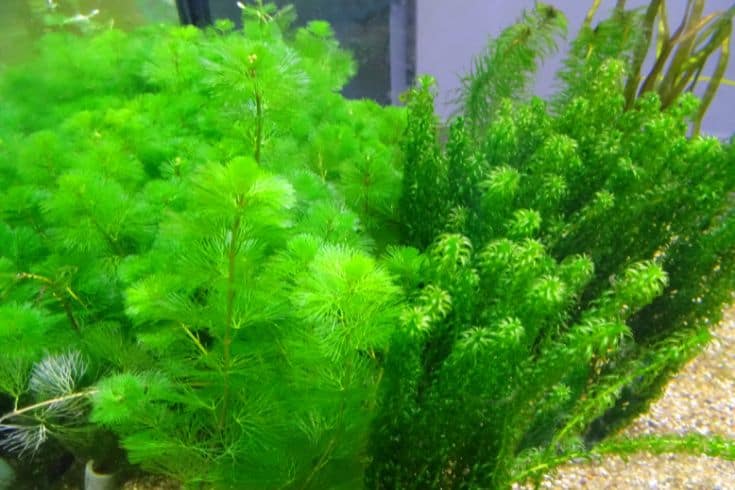
The Cabomba, or fanwort, is a fast-growing aquatic plant that is native to the Amazon Basin. This plant has long, slender leaves that are arranged in a fan-like shape. They’re usually favored in planted tanks because of their captivating appearance, but they also work well in a goldfish pond where they can help with nitrate control.
One of the benefits of the Cabomba is that it can grow quite large, providing plenty of cover and shade for goldfish. It is also relatively hardy and will be able to withstand the enthusiastic antics of goldfish. With regards to water parameter preferences, cabombas generally favor slightly acidic to neutral water, with a temperature range of 72-82 degrees Fahrenheit.
Cabombas can be propagated by dividing the plant into multiple pieces, each with a few leaves. They can also be grown from cuttings. When kept in an aquarium or goldfish pond, the Cabomba must be trimmed regularly to prevent it from taking over the entire space.
4. Water Sprite (Ceratopteris thalictroides)

With such a large and diverse range of plant life available, choosing which plants are best for your goldfish pond can be difficult. However, one plant worth considering is the water sprite (Ceratopteris thalictroides). This plant is native to tropical and subtropical regions around the world, and is an excellent choice for goldfish ponds.
The sort of substrate you have in your pond will largely determine which plants will thrive, and water sprite is no different. It prefers to grow in several inches of substrate, such as gravel or sand. Once you have your substrate in place, simply plant the water sprite in it and let it do its thing.
One of the key benefits of water sprite is its ability to oxygenate the water. This is achieved through its large and fast-growing leaves, which extract carbon dioxide from the water and release oxygen. This process keeps the algae population in check and provides the fish with vital oxygen.
5. Water Wisteria (Hygrophila difformis)

Some plants are known for their wide variety of colors, but the water wisteria (Hygrophila difformis) is a plant that is known for its uniform shade of green. Its bright green leaves are a joy to behold, and its ability to prosper in a wide variety of water conditions makes it an ideal plant for goldfish ponds.
If nutrient cycling is something you’re interested in, water wisteria is a great plant to have around. It is known for absorbing superfluous nutrients such as nitrates and phosphates from the water, which helps keep algae growth in check.
Cuttings, a relatively fast-growing plant, can propagate water wisteria. Once it has become established, it will require regular trimming to prevent it from taking over the pond.
Best Non-Edible Plant
Not every plant is going to be something that your goldfish can (or should) munch on. In fact, some plants can be harmful to goldfish if ingested. Non-edible plants are still a valuable addition to any goldfish pond, however, and these are our top recommendations:
6. Anacharis (Elodea densa)

Fish pond owners understand the appeal of a beautiful, aesthetically pleasing habitat for fish. But what many don’t realize is that the plants in their pond play a crucial role in the overall health of their fish. Anacharis, also known as Elodea densa, is one such plant. It is highly compatible with popular pond fish species such as goldfish and koi fish.
Anacharis is a great plant for beginners because it does a fabulous job of keeping your fish safe and is also very easy to take care of. Anacharis requires little to no attention and can help to keep your pond clean by absorbing excess nutrients from the water.
If you are looking for a plant that is both beautiful and functional, anacharis is worth considering. Once established, it will provide your pond with much-needed shade and cover for your fish.
7. Anubias (Anubias)

With a maximum height of approximately 24 inches tall, Anubias is a good choice for goldfish ponds. However, it is a slow-growing plant, so don’t expect it to reach its full potential overnight. Anubias is best suited for ponds with a moderate to high water flow, as this will help to prevent it from getting too much build-up of debris on its leaves.
This plant is very easy to care for and can act as an effective water oxygenator when grown in deep water. They also make superb water purifiers that will help to keep your pond clean and free of harmful toxins. When it comes to plants that maintain your pond’s water quality, you really can’t go wrong with anubias. And because goldfish are known to be such messy fish, a plant that helps to keep the water clean is always a valuable addition.
Ultimately, Anubias is a great all-around plant for goldfish ponds. It is easy to care for, oxygenates the water, and helps to keep the pond clean. What more could you ask for?
8. Hornwort (Ceratophyllaceae)
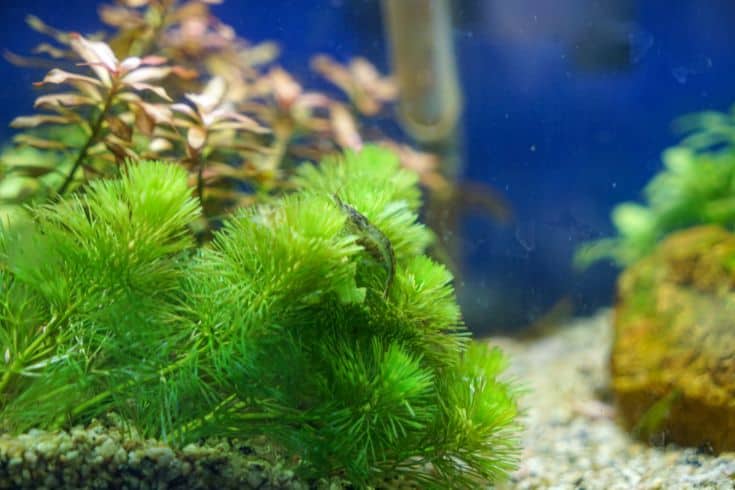
Hornwort is another excellent plant for goldfish ponds. It is a highly oxygenating plant that can help to keep your pond’s water clean and clear. Hornwort is also known for its ability to absorb superfluous nutrients such as nitrates and phosphates from the water. This makes it an ideal plant for ponds with high stocking densities or those that are prone to algae blooms.
Hornwort is a very fast-growing plant and can reach lengths of up to 6 feet tall in just a few short months. This makes it an excellent choice for ponds needing extra help in the oxygenation department. Hornwort is also very easy to care for and can be left to its own devices once established.
A hornwort is a great option if you are looking for a plant that will help keep your pond’s water clean and clear. It is also an excellent choice for ponds that need extra oxygenation help.
9. Onion Plant/Water Onion (Crinum calamistratum)

The onion plant, also known as Crinum calamistratum, is a great choice for goldfish ponds. Despite what its name would suggest, this plant belongs to the lily family. Onion plants are known for being versatile, though they do require some extra care when compared to other pond plants.
One thing to note about these plants is their bulbs should never be fully submerged. Doing so will cause the plant to rot and die. Onion plants are best suited for ponds with a moderate water flow, as this will help keep their bulbs from getting too much debris build-up.
While they may require a little extra care, onion plants are definitely worth the effort. Their long, wavy leaves make them a beautiful addition to any pond, and their ability to absorb nutrients from the water makes them an excellent choice for ponds with high stocking densities.
10. Waterweed (Elodea canadensis)

The elodea plant, also known as Elodea canadensis, is a great choice for goldfish ponds. This plant is native to North America and can adapt to all sorts of water temperature and hardness levels, though it prefers cool water. Elodea is also very easy to care for and can be left to its own devices once it is established. However, they are known for their ability to reproduce quickly, so you may need to thin out your elodea population every so often.
Elodea plants are excellent oxygenators and can help to keep your pond’s water clean and clear. They are also known for their ability to absorb water nutrients, making them an excellent choice for ponds with high stocking densities or those prone to algae blooms.
Elodea is a great choice if you are looking for a plant that will help keep your pond’s water clean and clear. It is also an excellent choice for ponds that need extra oxygenation help.
Under Water Plants
11. Amazon Sword

The Amazon sword, also known as Echinodorus amazonicus, is a great choice for goldfish ponds. This plant originates from South America and is known for its large, broad leaves. Because of their size, Amazon swords are best suited for ponds with a good deal of surface area – which goldfish ponds typically have.
To keep these plants healthy, it is important to provide them with a substrate they can root in. Amazon swords are also heavy feeders and will benefit from being fertilized regularly. We recommend using a fertilizer high in nitrogen and potassium, as these are the nutrients these plants typically lack.
The Amazon sword is a great choice if you are looking for a plant that will add some serious flair to your pond. Just be sure to give them the space they need to grow and the nutrients they need to thrive.
12. Java Fern
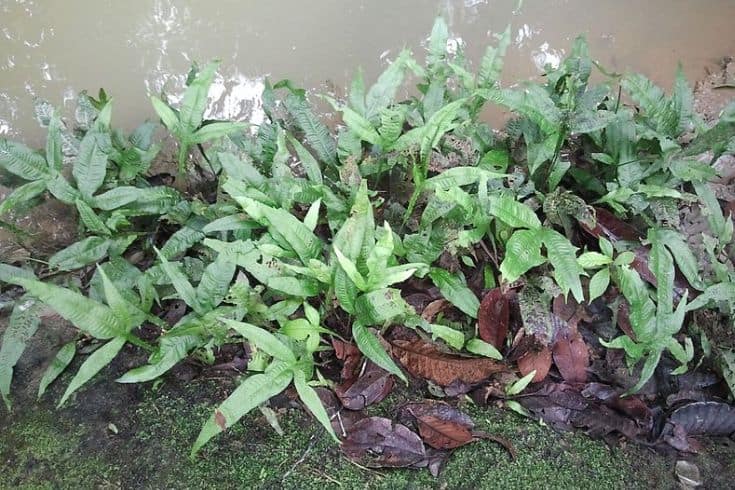
This fast-growing plant is one of the best choices for goldfish ponds. Java fern is a great plant for beginner pond keepers as it is very easy to care for. This durable plant is native to Southeast Asia and thrives in the same parameters as goldfish. In fact, these plants are often used in tanks with goldfish to help control algae growth.
Using fishing lines or zip ties, Java fern can be attached to rocks or driftwood. Once the plant is established, it will begin to produce “runners” that can be used to propagate new plants. These runners can be left in the pond or transplanted to other areas of the tank or pond. When cared for properly, java fern can live for many years.
If you are looking for an easy-to-care-for plant that will help to control algae growth, the java fern is a great choice. These plants are also very aesthetically pleasing and can add a nice touch of greenery to your pond.
13. Bolbitus
Strange as it might sound, the bolbitus plant is actually a fern. These plants are native to Africa and Asia and are known for their long, flowing leaves. Bolbitus plants do best in ponds with a good deal of surface area, as they need plenty of space to spread out. Much like their Java fern cousins, bolbitus plants are great for controlling algae growth.
The best way to propagate bolbitus plants is by dividing the rhizome. This can be done by carefully removing the plant from the pond and then gently separating the rhizome into two or more pieces. Each piece should have at least one leaf attached and can then be replanted in the pond.
Once established, bolbitus plants are very easy to care for. These plants do not require any special substrates or fertilizers and will do well in most ponds. If you are looking for a plant that will add some serious greenery to your pond, the bolbitus is a great choice.
14. Marimo Ball
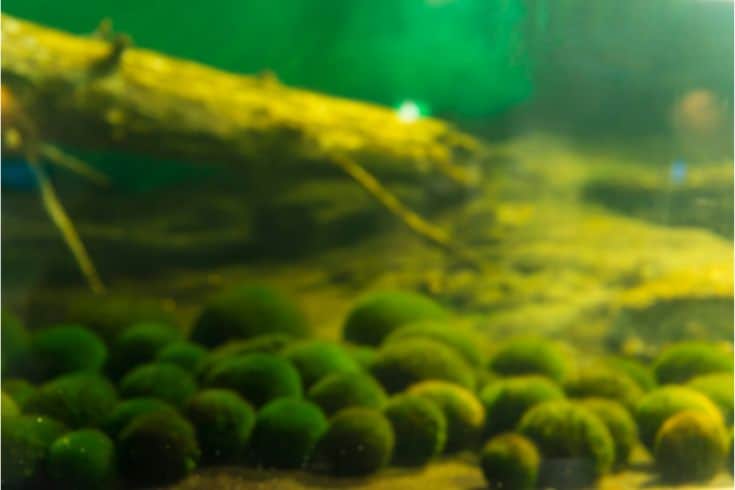
This right here is an adaptable plant that looks like a small, green ball. Marimo moss balls are actually not moss at all, but are instead a type of algae. These plants are native to Japan, Iceland, and Scotland and have been a popular ornamental plant for many years. At their largest, marimo moss balls can reach up to four inches in diameter, making them a nondescript addition to large ponds that will add some nice greenery.
Marimo moss balls are very easy to care for and do not require any special substrates or fertilizers. As one would expect, these plants prefer ponds with a high dissolved oxygen level. These balls can be left to float freely in the pond or can be attached to rocks or driftwood using fishing lines or zip ties. In most cases, marimo moss balls will live for many years with little to no care.
Goldfish are known to nibble on marimo moss balls from time to time. While this will not hurt the plant, it can cause the ball to misshapen. If you notice your goldfish nibbling on the moss balls, you can try to discourage this behavior by providing other food sources or moving the plants to a different part of the pond.
Floating Plants
15. Water Hyacinth
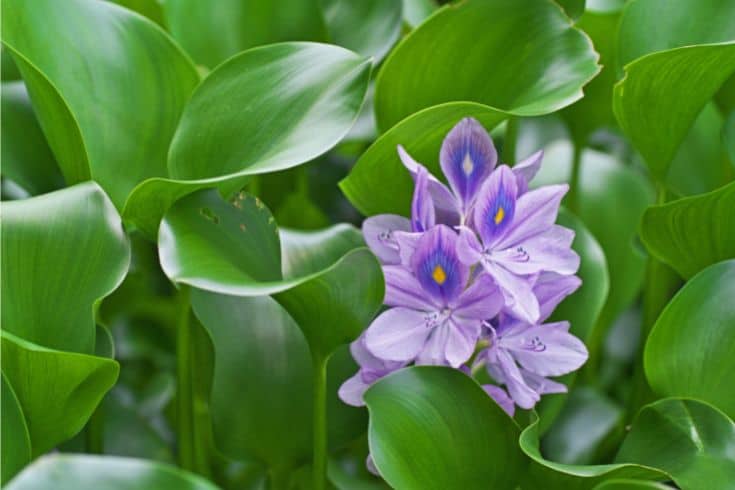
Goldfish pond water requires a lot of dissolved oxygen, which can be achieved by having plants float on the water’s surface. Water hyacinth is one great example of the types of plants that can provide this benefit. Water hyacinth is a floating plant that has very pretty, blue-purple flowers. These resilient plants are native to South America but have become naturalized in many other parts of the world.
Despite being one of the most hardy plant species, water hyacinth requires great care and maintenance if you want it to thrive in your goldfish pond. These fast-growing plants can quickly take over a pond if left unchecked. Water hyacinth also has a very large root system that can clog filters and pumps, so regular maintenance is a must.
If you are up for the challenge, water hyacinth can be a beautiful addition to your goldfish pond. Just be sure to keep a close eye on these plants and remove any that start to take over.
16. Water Lettuce

Water lettuce is another floating plant that can provide some dissolved oxygen to your goldfish pond. These plants are native to Africa and have long, slender leaves that are light green in color. Water lettuce also has small, white flowers that bloom on occasion. Water lettuce is a great choice if you want a plant that will add some color and interest to your pond.
Although water lettuce is not as fast-growing or invasive as water hyacinth, it still requires a fair amount of care and maintenance. These plants are very sensitive to changes in water quality, so regular testing and water changes are a must. Water lettuce also prefers ponds with a lot of dissolved oxygen, so be sure to aerate your pond if you plan on keeping these plants. A good water pump can also help to circulate the water and keep the lettuce healthy.
Your goldfish will probably nibble on water lettuce occasionally, but this will not hurt the plant. In fact, some goldfish keepers appreciate the extra help these fish provide in keeping the lettuce trimmed. Be that as it may, we always recommend keeping an eye on your fish to make sure they are not overeating.
17. Frogbit

Frogbit, scientifically known as Limnobium laevigatum, is another floating plant that can help to oxygenate your goldfish pond. These plants are native to Europe and parts of Asia, though they were introduced to North America in the 1930s and have since become naturalized. Frogbit has round, floating leaves that are covered in small hairs. They float on the water’s surface and can reach up to 12 inches in diameter.
Frogbit is a very easy plant to care for and can tolerate a wide range of water conditions. Goldfish keepers appreciate these plants for their hardiness and ability to thrive in most ponds. However, frogbit can become invasive if left unchecked. These plants reproduce very quickly and can quickly take over a pond. Be sure to remove any excess plants regularly to keep them under control.
Frogbit can be a great addition to your goldfish pond if you stay on top of maintenance. These plants are very pretty and can provide your tank with a good deal of shade and cover. Your goldfish will also enjoy nibbling on the leaves from time to time, so frogbit can also be a good source of food.
18. Water Mimosa

Unlike the Mimosa Pudica, the Water Mimosa ( Neptunia oleracea) is not a plant that will fold its leaves in when touched. This floating fern is native to South America but has since been introduced to many tropical and subtropical regions around the world. Water Mimosa can grow quite large, with leaves reaching up to 2 feet in length.
Water Mimosa is a very pretty plant that can add a lot of color and interest to your goldfish pond. Their leaves are shaped like little hearts and are bright, deep green in color. On some occasions, these plants will also produce small, yellow flowers that resemble a pretty little sun.
Although Water Mimosa is not as invasive as some other plants on this list, they can still become a problem if left unchecked. These plants reproduce very quickly and can quickly take over a pond. Be sure to remove any excess plants regularly to keep them under control.
19. Azolla
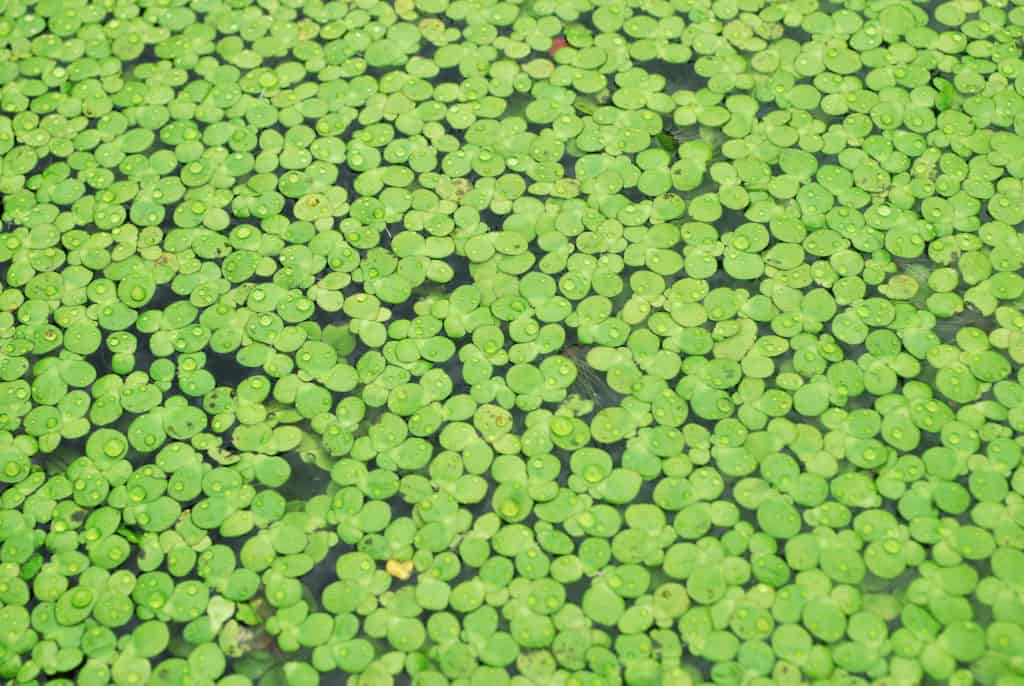
Last but not least, we have Azolla, otherwise known as the mosquito fern. This floating plant is native to many parts of the world, including North America, Europe, Asia, and Africa. Azolla is a very small plant, with leaves that only grow about an inch long.
Despite their small size, Azolla plants can greatly impact your goldfish pond. These plants are known for their ability to absorb nitrogen and other pollutants from the water. This can help to keep your pond water clean and clear. Goldfish keepers also appreciate these plants for their hardiness and ability to thrive in most ponds.
What Do Plants Do For Goldfish Ponds?
When goldfish ponds are designed and built properly, they provide a beautiful and serene environment to relax and enjoy the outdoors. But ponds can also be a source of frustration if they are not maintained properly. Planting the right plants in your goldfish pond will help to ensure that it remains healthy and attractive for years to come.
The right plants can play an important role in keeping your pond water clean and clear. They do this by absorbing nutrients and pollutants from the water, which would otherwise lead to algae growth. The right plants can absorb excess nutrients in the water, thus preventing algae blooms.
In addition to their water-cleansing abilities, plants also provide valuable habitats for aquatic creatures. Goldfish and other pond creatures need places to hide from predators, escape the sun’s heat, and lay their eggs. A well-planted goldfish pond will provide all of these things, and can become a haven for wildlife.
Finally, plants also help to shade the pond surface, which reduces evaporation and keeps water temperatures cooler in summer. Water temperature variations can stress goldfish out, and plants provide excellent shade for goldfish ponds to help in this regard.
The Takeaway
We hope you enjoyed this article on the best plants for goldfish ponds. Goldfish are beautiful creatures that deserve to have a healthy and happy home. By adding some of these plants to your pond, you can help to create a healthy environment for your fish. Just be sure to stay on top of maintenance and remove any excess plants as needed to keep them under control.
Thanks for reading, and please share this article if you found it helpful!
